From the shallows of freshwater rivers to the depths of saltwater oceans, some fishes have adapted remarkable abilities: using fins or legs that allow them to walk on bottom surfaces and maneuver in their aquatic homes. And in this article, we will explore those fish species.
Can Fish Have Actual Legs?
No, fish cannot have human-like legs, but they can have organs that resemble legs. These are their fins – pectoral, pelvic, and anal fins that resemble limbs and aid them in navigating their environment. Fin rays or lobed fins are more accurate names, but they can function similarly to arms and legs.
However, some species, such as the mudskipper, a fish that can walk on land, have evolved true leg-like organs.
List of 25 Fish Who Can Walk
Here you will find 25 fish species that have the extraordinary ability to walk along the bottom of water bodies. We’ll explore them all and delve into their preferred aquatic dwellings. But first, have a look at this chart to understand their habitat.
| Sea water Fish | Fresh water Fish | Both Sea and Freshwater Fish |
| Warty frogfish | Snakehead fish | Mudskipper (mainly brackish) |
| Red-lipped batfish | Tiktaalik roseae | Archerfish (mainly fresh) |
| Epaulette shark | Short-tailed River Stingray | Four-eyed Fish (mainly fresh and brackish) |
| Red Gurnard | Walking Catfish | |
| Spotted Handfish | Chinese Hillstream Loaches | |
| Pacific Leaping Blenny | Polypterus Lapradei | |
| Skate | West African lungfish | |
| Snipefish | Panderichthys Rhombolepis | |
| Sea Robin | Climbing Gourami | |
| Coelacanth | Giant Salamander | |
| Mexican Axolotl | ||
| Thorny Catfish |
Seawater (Salt Water) Fish Who Can Walk
Warty Frogfish
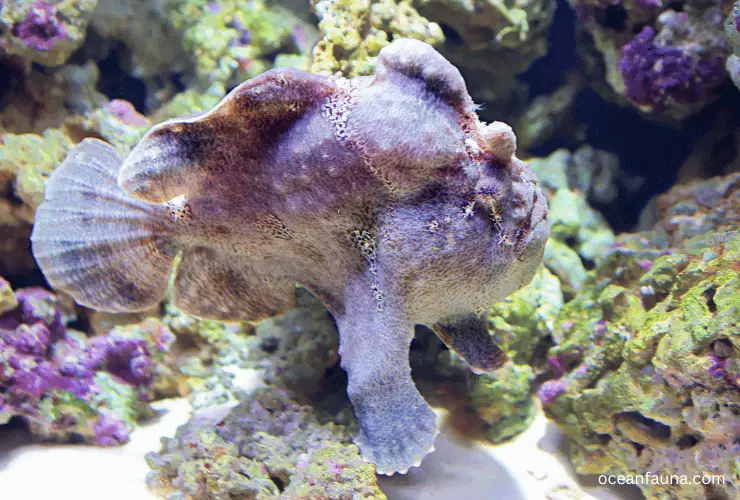
- Other name: Clown frogfish.
- Scintific name: Antennarius Maculatus.
- It gets its name from its warty skin and its ability to hop across the ocean floor.
The warty frogfish feed on crustaceans, small fish, and other invertebrates. They can be found in coral reefs, seagrass beds, and rocky areas, mainly in the Indo-Pacific region.
Warty frogfish move along the bottom of the sea in a unique way, known as angling. They use their pectoral fins to look like legs, to walk rather than swim. Angling behaviour is exhibited by resting on the bottom and using its fins to walk to set up an ambush for prey.
Red-lipped Batfish
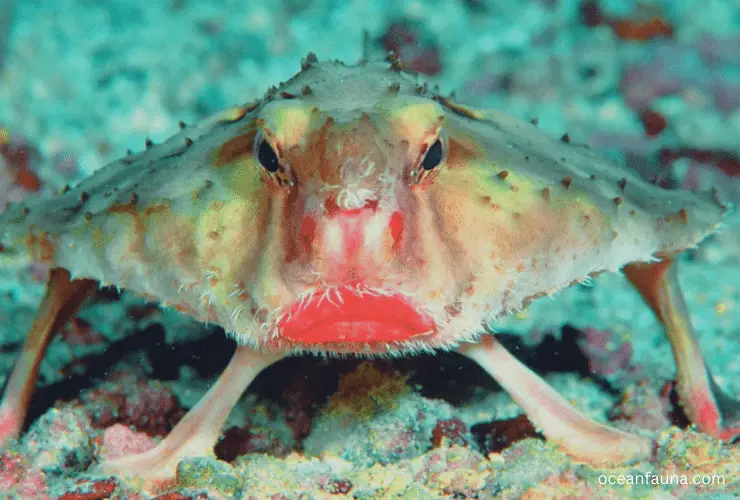
- Other name: Galapagos batfish.
- Scientific Name: Ogcocephalus Darwini.
- It gets its name because of its bright red lips.
The red-lipped batfish is native to the waters around the Galapagos Islands in the Pacific Ocean. It lives in shallow, sandy seafloors where it searches for food using its fins that look like legs. The Batfish uses its fins and peculiar way of “walking” on the seafloor to maneuver and catch prey. Red-lipped Batfish mainly feed on small marine organisms like crustaceans, polychaetes, mollusks, and other fishes.
Epaulette shark
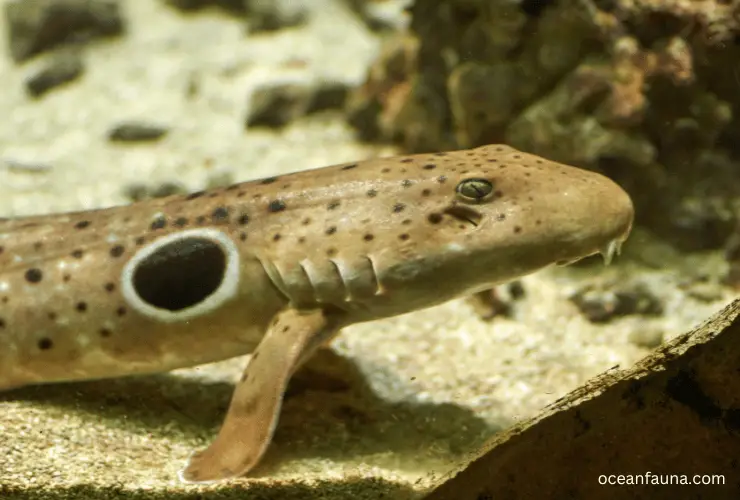
- Other name: Walking Shark, longtail carpet sharks
- Scientific name: Hemiscyllium ocellatum
- This shark gets its common name from its unique ability to “walk” along the ocean floor using its pectoral and pelvic fins.
The epaulette shark is found in shallow, warm waters near coral reefs. This species of shark feeds on small invertebrates and benthic organisms like crabs, mollusks, sea urchins, and other fish. They also have an interesting defense mechanism: they walk away from the predator rather than swim away when threatened.
Red Gurnard
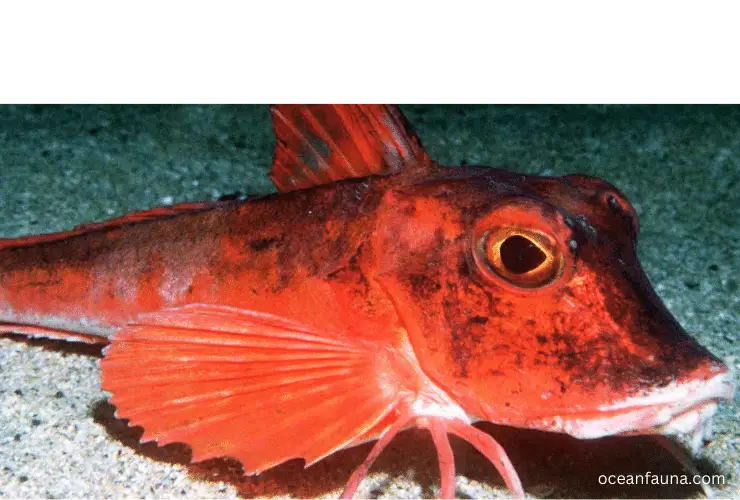
- Other name: Sea perch, Scorpionfish, red ocean perch, and red rock perch.
- Scientific name: Chelidonichthys kumu.
The red gurnard is native to the waters from the Australian coast to the Adriatic Sea and typically inhabits more shallow environments in depths of less than 100 m. This species can also be found across much of the Indo-Pacific region and New Zealand.
What makes it stand out amongst other aquatic creatures is its remarkable pectoral fins that look like legs, allowing it to ‘walk’ along the seafloor with ease. The diet of these fish consists of invertebrates like crabs, shrimps, crayfish, and small fish. Red gurnard also use their strong pectoral fins to dig in the sand and uncover prey items hiding beneath the surface.
Spotted Handfish
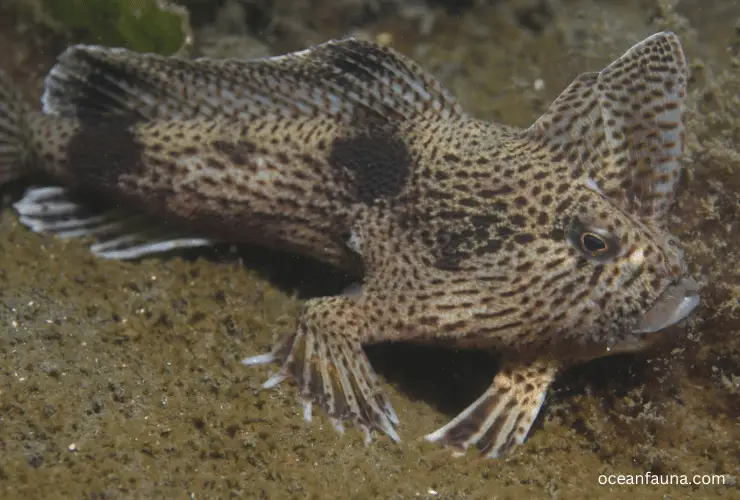
- Other name: Prickly-skinned Handfish, Tortoiseshell Fish.
- Scientific name: Brachionichthys Hirsutus
- Get the name from its ability to use its fins as “hands” to walk on the seafloor.
The Spotted Handfish is native to south-eastern Australia and can be found in parts of Tasmania and Victoria. This species is typically found in depths between 1-60 meters, where they make their homes among areas with seagrass or seaweed.
This species uses its pectoral fins to ‘walk’ on the sea floor while also using them to propel itself through water and catch food. The diet of this fish consists primarily of small crabs, mollusks, and other invertebrates living in their habitat.
Pacific Leaping Blenny
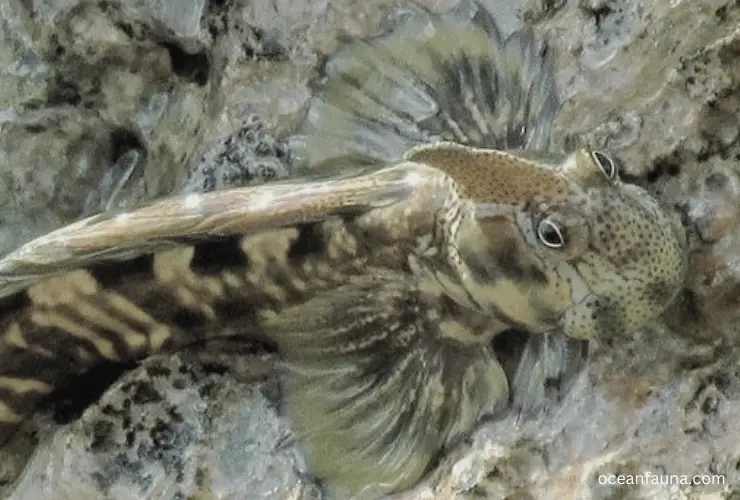
- Other name: Leaping rockskipper.
- Scientific name: Alticus Saliens.
- The Pacific Leaping Blenny has earned its name from its remarkable ability to quickly jump between crevices or holes in the limestone rocks it calls home when feeling threatened.
Found between the Samoa islands to Marianas and Cook Islands in the western and southern Pacific Ocean lies The Pacific Leaping Blenny – an aquatic species that resides among coral reefs. Recent research uncovers how this peculiar fish was able to make a successful transition from swimming below the water surface to land habitation.
Skate
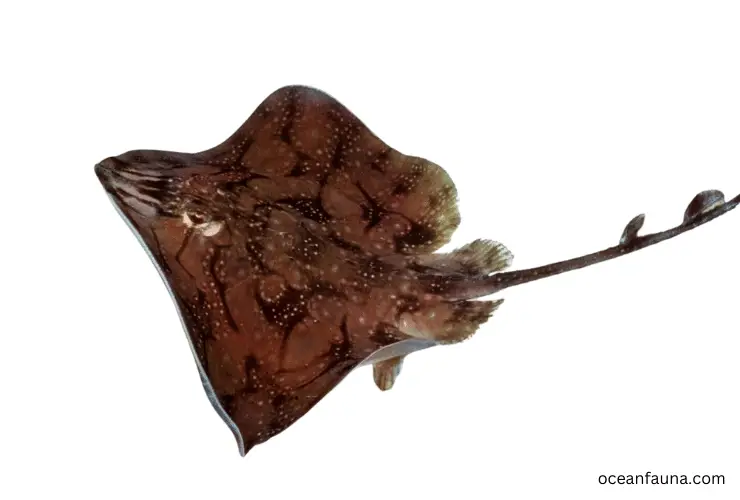
- Other name: Skate wings, Sea skate
- Scientific name: Rajidae
Skates are a type of fish that have flat, diamond-shaped bodies and pectoral fins that resemble wings. Skates have adapted to life on the ocean floor by having long tails, tough outer skin, and modified fins to help them get around. They feed on small invertebrates like mollusks, crustaceans, and other fish.
Snipefish
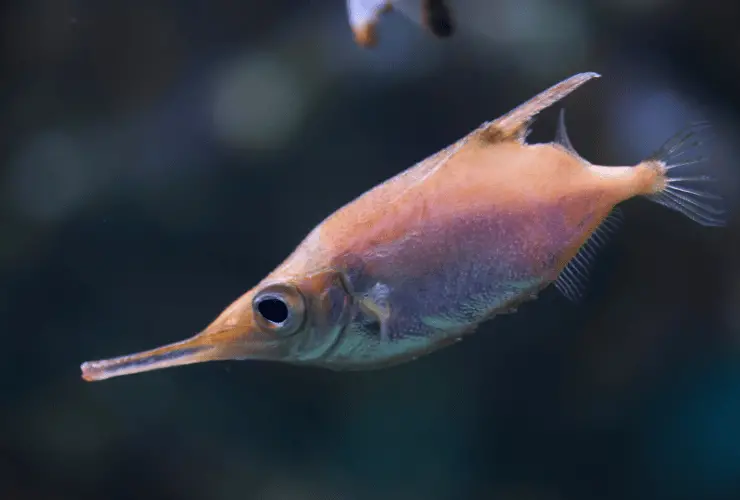
- Other name: Bellowfish, Spine trumpet fish.
- Scientific name: Macroramphosus scolopax.
The slender and diminutive snipefish flourish in the tropical and subtropical seas of the eastern Atlantic, North and Baltic Seas, Mediterranean Sea, West Pacific Ocean, as well as the Indian Ocean. With its long snout-like mouthparts, it is equipped to suction up small invertebrates for sustenance.
Their diet mainly consists of zooplankton, crustaceans, and small fish they catch while swimming in the water. Snipefish have adapted to life on the ocean floor by having long pectoral fins that help them maneuver around the seafloor.
Sea Robin
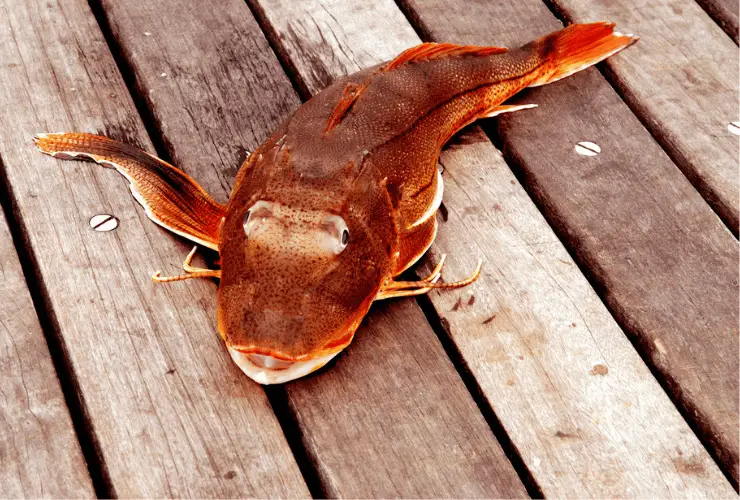
- Other name: Gurnard
- Scientific name: Triglidae
- Sea Robin is aptly named due to the resemblance of their fan-shaped pectoral fins that move quickly like wings when they swim.
The sea robins are found in tropical, subtropical and temperate waters of the North Atlantic and Mediterranean Sea. They inhabit sand or muddy bottoms in depths ranging from a few meters to several hundred meters.
Sea Robins feed on small crustaceans like shrimp, crabs, and worms that suck up off the ocean floor with suction-like mouths. They use their large pectoral fins to help them move along the seafloor and stir up the sediment to uncover prey items hiding underneath.
Coelacanth
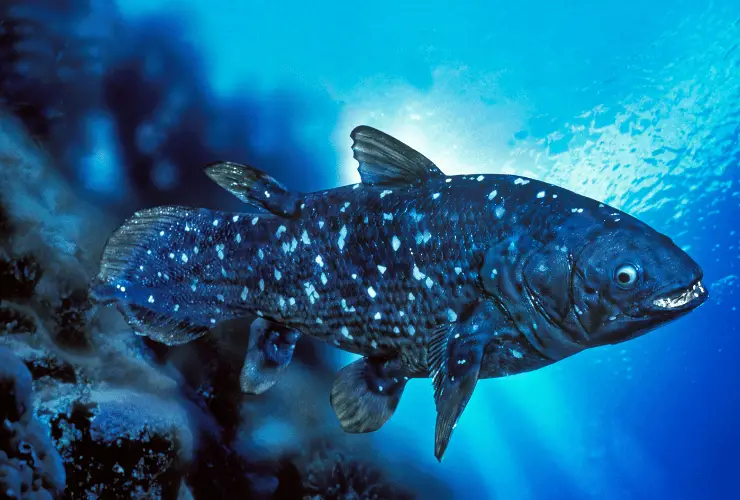
- Scientific name: Latimeria chalumnae
- Deriving its name from the Greek words for “hollow spine,” this fish is unique in that it has an extraordinary skeletal structure.
A true living fossil, the Coelacanth has traversed throughout time for more than 360 million years – a rare species among us. Coelacanths are primarily located in the Comoros Islands off Africa’s eastern coast and near Sulawesi, Indonesia.
These organisms have adapted to living on the ocean floor by having specialized pectoral fins that aid them when traversing bumpy terrain. They feed on fish, cephalopods, crustaceans, and other invertebrates found in their habitat.
Freshwater Fish Who Can Walk
Snakehead fish
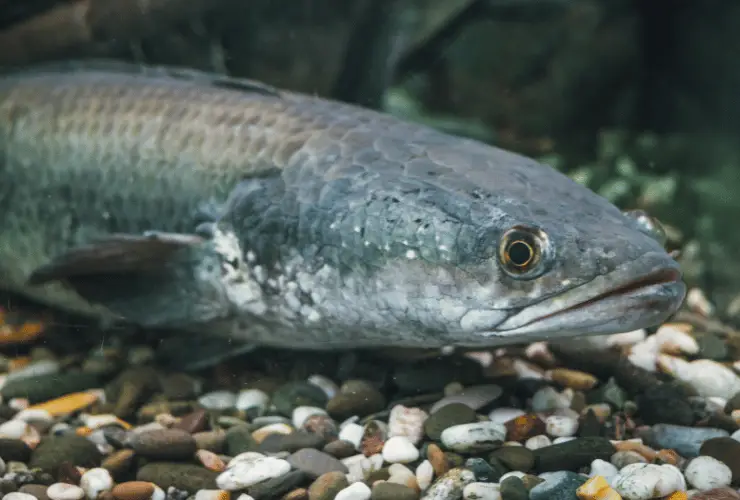
- Other name: Murrels
- Scientific name: Channa argus
- The snakehead fish gets its distinctive name from the unique shape of their head, which strikingly resembles that of a snake.
The snakehead fish is found in tropical, subtropical, and temperate freshwater regions of Europe, Asia, and North America. Snakeheads are well-adapted to living on land as they have thick scales protecting them from the environment and the ability to breathe air using an organ near their gills.
They can walk on land with the help of their long and serrated pectoral fins. On land, snakeheads feed on small insects, invertebrates, and other fish they can catch in shallow water. In the water, they mainly feed on crustaceans and small fish.
Tiktaalik roseae
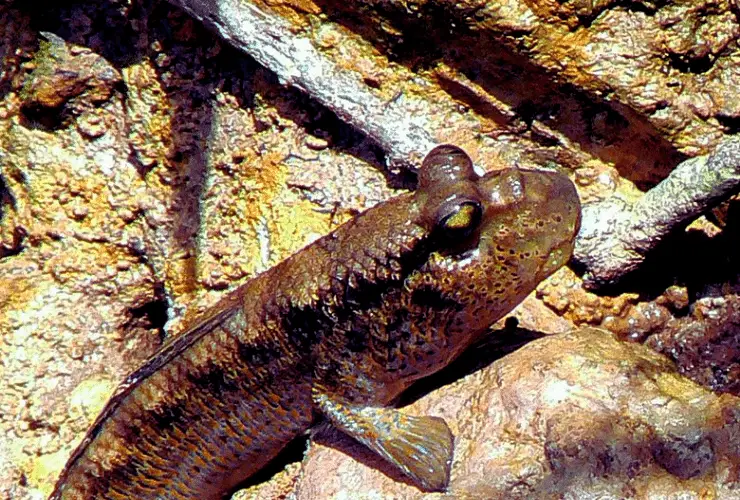
- Scientific name: Tiktaalik
- The name Tiktaalik is derived from the Inuktitut language of Canada’s eastern Indigenous population.
The Tiktaalik roseae is a transitional species between sea creatures and land-dwelling animals. It is found in freshwater environments of the arctic circle, living in freshwater lakes and rivers.
Tiktaalik is adapted to live on land by having robust forelimbs that allow them to move around on their hind fins, which have been transformed into limbs for walking. They also have a unique pectoral fin structure that allows them to move and maneuver in shallow water when combined with their hind fins.
Tiktaalik feeds on small invertebrates like worms and insects, which they capture using the suction from their mouthparts. They can also eat some plant matter.
Short-tailed River Stingray
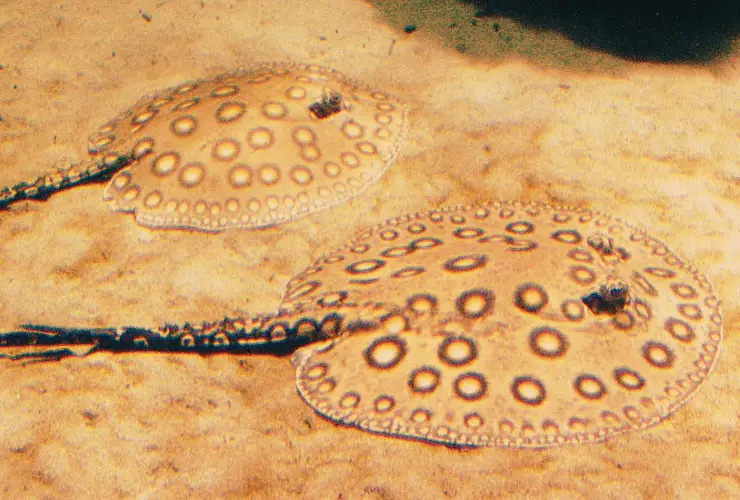
- Other name: Giant freshwater stingray
- Scientific name: Potamotrygon brachyura
- They get their name since their tail is shorter than the rest of their body, compared to other species of stingray.
The short-tailed river stingray is found in the rivers and estuaries of South America, ranging from Peru to Brazil. The short-tailed river stingrays inhabit shallow muddy bottoms, where they feed on small fish and invertebrates like mollusks, worms, and crustaceans.
The short-tailed river stingrays have specialized pectoral fins that help them dig into the muddy floors of rivers and estuaries in search of food. They also use their pectoral fins to move around both on land and in the water as well as for protection from predators. The stingray’s tail is equipped with razor-sharp spines that can deliver powerful venom to ward off potential attackers.
Walking Catfish
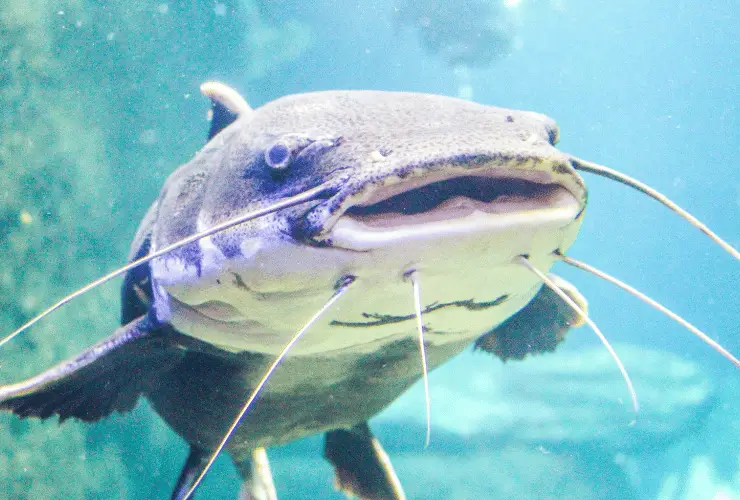
- Other name: Clarias catfish
- Scientific name: Clarias batrachus
- The walking catfish gets its distinctive name from its ability to walk on land with the aid of specialized pectoral fins.
Home to the tropics and subtropics, walking catfish fish can be found in freshwater bodies across Southern Asia – from Pakistan, India, Sri Lanka, Bangladesh, and Myanmar through to Thailand, Malaysia, Indonesia, Singapore, Borneo Laos, and finally, The Philippines.
These fish can use their pectoral fins to move around on land in search of food or new bodies of water. They primarily feed on insects, worms, crustaceans, and mollusks found in their habitat’s mud and shallow waters. Walking catfish can also breathe air, allowing them to survive outside water for an extended period.
Chinese Hillstream Loaches
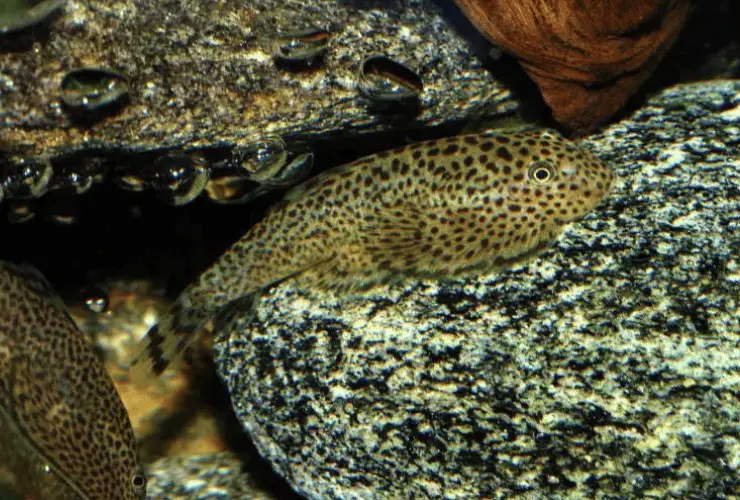
- Scientific name: Beaufortia kweichowensis
The Chinese Hillstream Loaches, native to the Yangtze River Basin in China, inhabit fast-flowing streams and rivers. These loaches are known for their unique body shape that resembles rocks on the riverbeds due to their flattened bodies and large pectoral fins.
These loaches use these specialized pectoral fins to cling onto rocks, allowing them to stay in one spot and feed on the algae and small invertebrates that live among the rock crevices. The Chinese Hillstream Loaches also have a specialized respiratory system that allows them to absorb oxygen from the fast-moving water around them.
Polypterus Lapradei
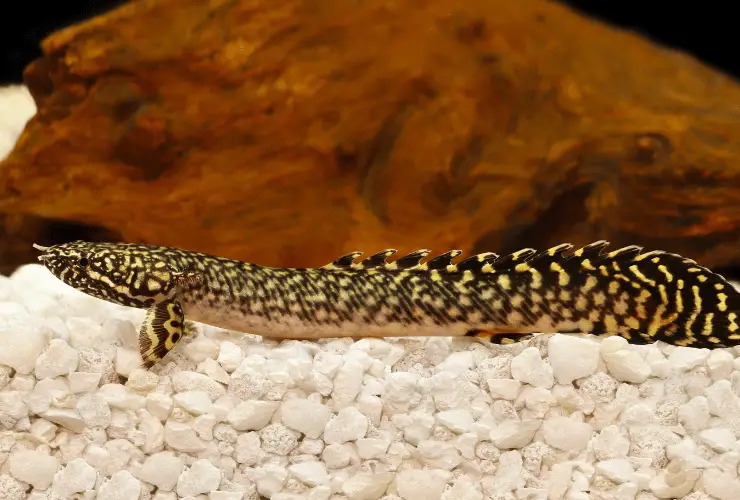
- Scientific name: Polypterus bichir lapradei
The Polypterus Lapradei is an African fish that can be found in the Nile River Basin and Lake Chad. These fish have a distinctive body shape with long, thin pectoral fins that allow them to move around in swift currents.
Polypterus Lapradei uses their specialized pectoral fins for both swimming and bottom-dwelling. They feed on small invertebrates like worms, crustaceans, mollusks, and some plant matter.
West African lungfish
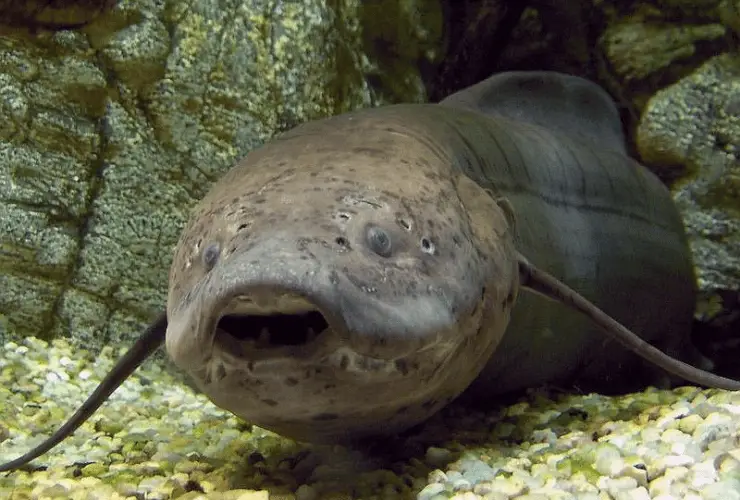
- Other name: Tana lungfish, African lungfish
- Scientific name: Protopterus annectens
- This freshwater lungfish is known for its ability to breathe air since they have two lungs, which allows it to survive in the shallow waters of Africa.
The West African lungfish has two specialized pectoral fins that help it move around on land. It can even climb up onto land and out of the water. The lungfish also has gills to absorb oxygen from the water.
West African lungfish feed on small invertebrates like worms, mollusks, crustaceans, and some plant matter. They can survive in both wet and dry seasons by burying themselves in the mud until the next rainy season. When they are active, these fish use their pectoral fins to navigate through shallow streams and rivers.
Panderichthys Rhombolepis
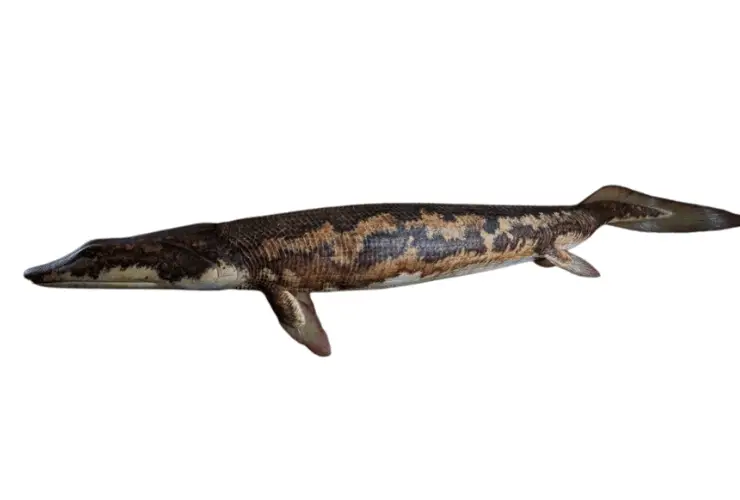
- Scientific name: Panderichthys
The Panderichthys Rhombolepis is an ancient fish from the Devonian period that had a unique body shape and specialized pectoral fins. This fish was believed to be capable of walking on land with the aid of its large, muscular pectoral fins.
This species of fish, which is now extinct, shared many characteristics with modern lungfish and tetrapods, suggesting that they could have been an intermediate species between primitive fishes and the first four-legged land animals. The Panderichthys Rhombolepis had lungs that allowed them to breathe the air outside of water.
They would feed on small invertebrates like worms, mollusks, and some plant matter.
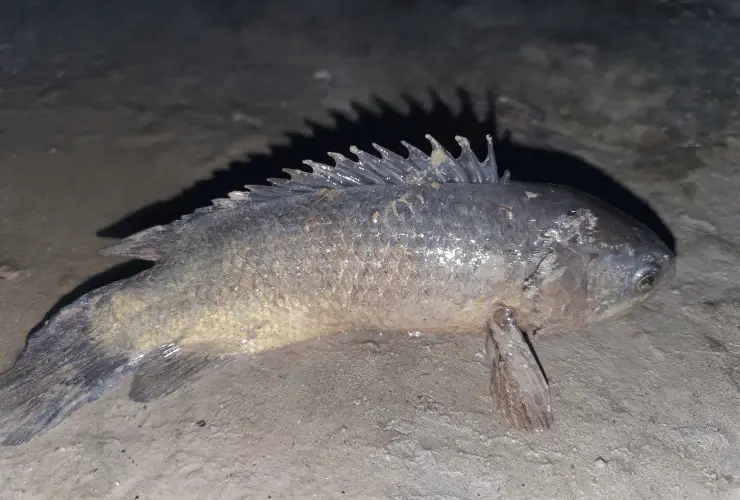
- Other name: Climbing perch
- Scientific name: Anabantidae
Native to India, Bangladesh, Indonesia, Malaysia, and Thailand’s sluggish streams and rivers is the climbing gourami. Their body has an unmistakable shape with large pectoral fins that permit them to clamber up rocks in search of new food sources or water. They primarily feed on small invertebrates such as worms, crustaceans, and mollusks.
Giant Salamander
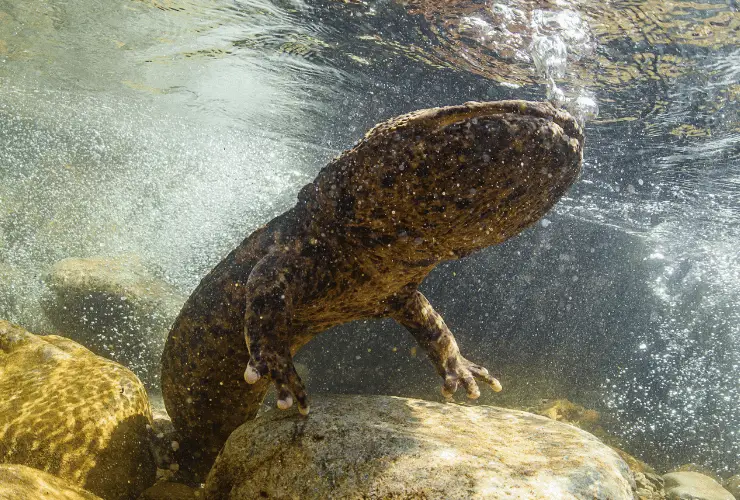
- Scientific name: Cryptobranchidae
The amazing fact about the giant salamander is that it can breathe through its skin, allowing them to survive in oxygen-poor waters. They have two specialized pectoral fins that help them move around in the water while they are hunting for their prey.
The giant salamander is an avid feeder with a diet consisting of aquatic insects, fish, frogs, crabs and shrimp. They can also feed on some plant matter when available. These giant amphibians live in slow-moving streams and rivers throughout eastern Asia and North America.
Axolotl
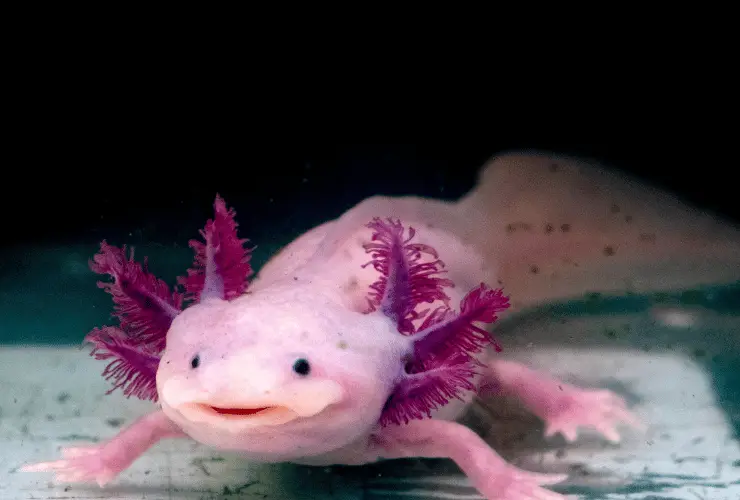
- Other name: Mexican walking fish
- Scientific name: Ambystoma mexicanum
- The origin of their name can be traced back to the ancient Aztecs, and it translates to ‘water dog’ or ‘water monster.’
The axolotl is a salamander that can breathe through its skin, allowing it to survive in oxygen-deficient waters. It has two specialized pectoral fins, allowing it to move around in the water with ease. The axolotl feeds on small invertebrates such as worms and mollusks as well as some plant matter when available.
This creature is found in the wild only in a handful of lakes around Mexico City and is considered a critically endangered species. To conserve this amazing creature many conservation efforts are underway to protect the axolotl and its habitat.
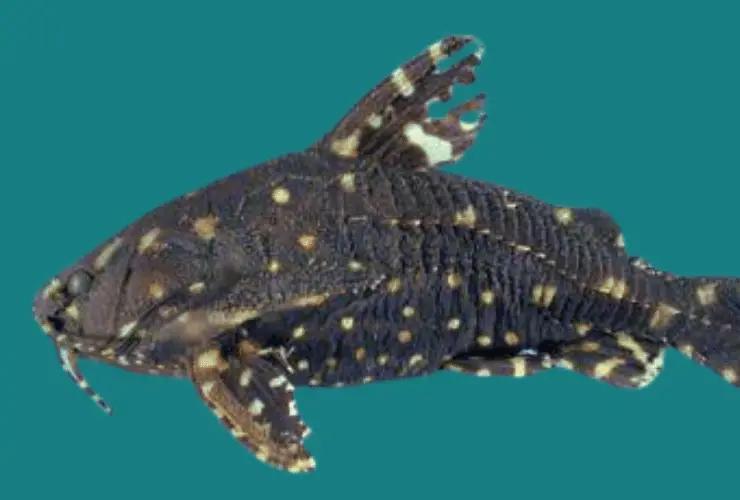
- Scientific name: Doradidae
The thorny catfish is an ancient freshwater fish from South America with a unique body shape and two specialized pectoral fins. It is most commonly found in Brazil, Argentina, Uruguay, and Paraguay rivers and streams.
This species primarily sustains itself by scavenging for detritus. They scour the sediment to locate their meals.
Common (Both Seawater and Freshwater Living) Fish Who Can Walk
Mudskipper
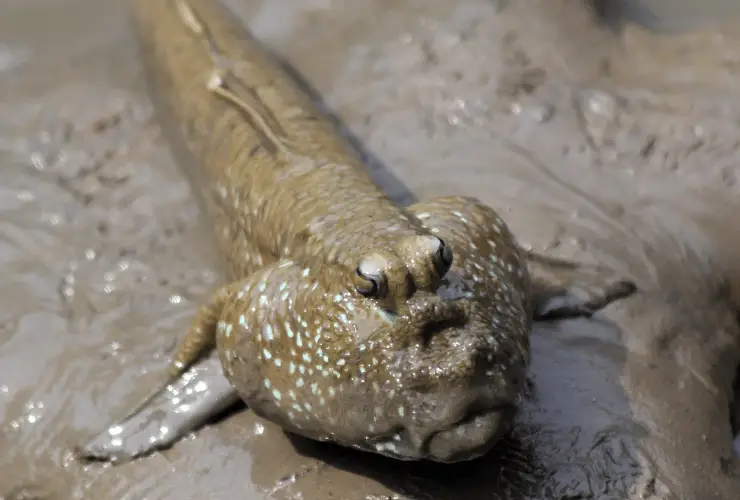
- Scientific name: Oxudercinae
- They mainly prefer brackish water (mixed of salt and freshwater)
The mudskipper is a type of fish with specialized pectoral fins that allow them to move across land and even up vertical surfaces. It can be found in the warm, muddy waters of the Indo-Pacific region, living at the interface between land and sea.
Mudskippers feed on a variety of animal and plant matter, including insects, worms, crustaceans, mollusks, and algae. They also supplement their diet with the occasional amphibian or small fish.
Archerfish
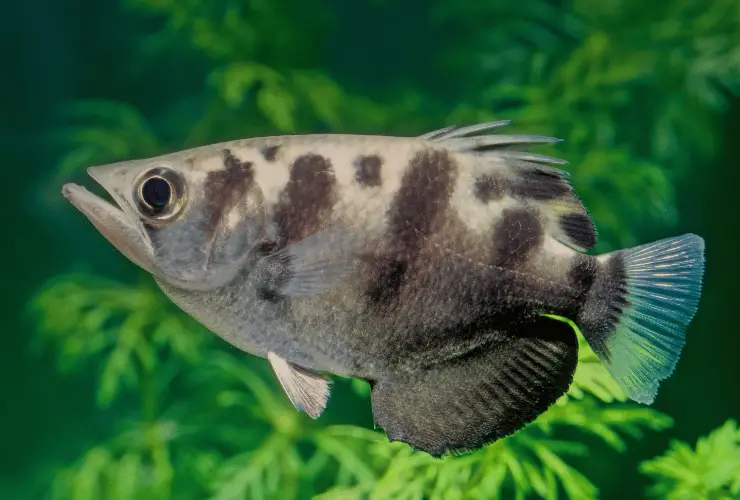
- Scientific name: Toxotes
- They mainly prefer freshwater but can also live in salt water and brackish water.
An archerfish is a group of fish that are found in the tropical and subtropical waters of Australia, Southeast Asia, and India. It gets its name from its unique ability to shoot a stream of water at insects above the surface with astonishing accuracy.
In addition to insects, archerfish feed on small fish and crustaceans that live near the water’s surface. They have two specialized pectoral fins for navigating in shallow waters and can even be seen ‘walking’ across the land during low tide.
Four-eyed Fish
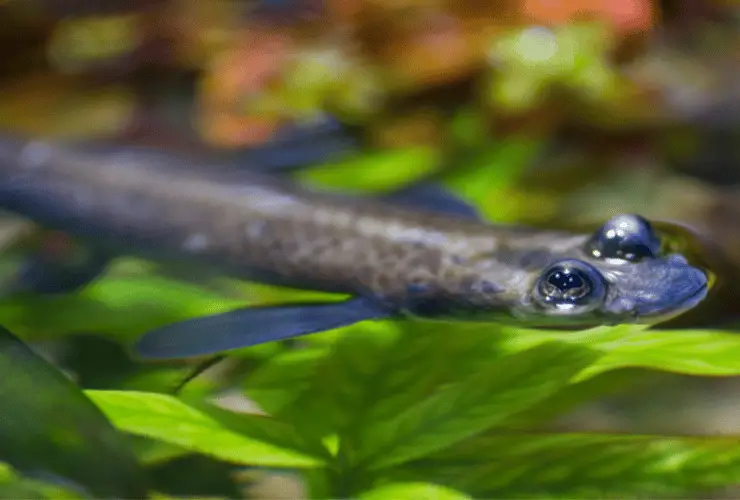
Scientific name: Anableps
They mainly prefer freshwater and brackish water.
The four-eyed fish is a species of fish that can be found in the shallow waters of Central America, South America, and Mexico. Its name comes from its two large eyes on either side of its head that allows it to spot prey above and below the surface at the same time.
The four-eyes fish has two unique pectoral fins that permit it to move about the water’s surface and mudflats in search of sustenance. This species primarily eats insects, small fish, worms, as well as crustaceans for a balanced diet.
Final Words
In this article, I have explored 25 fish species that possess either legs or special pectoral fins to act as substitutes for them. While their habitats vary–some living in saltwater, most inhabiting freshwater, and some even surviving in brackish water.
Many of the species are endangered due to destructive human activity such as habitat destruction, overfishing and pollution. One of the species, named Panderichthys Rhombolepis, is extinct.
We have to take responsibility for conserving these species and the delicate ecosystems that sustain them. This can be achieved by introducing laws restricting human activities that are detrimental to their environment, investing in conservation efforts and educating communities on sustainable fishing practices.
Reference and Image Source:
https://www.wildlifetrusts.org/
https://earthtimes.org/nature/jumping-fish-tale-earliest-land-creatures/1315/
https://www.britannica.com/animal/skate-fish


Good information.